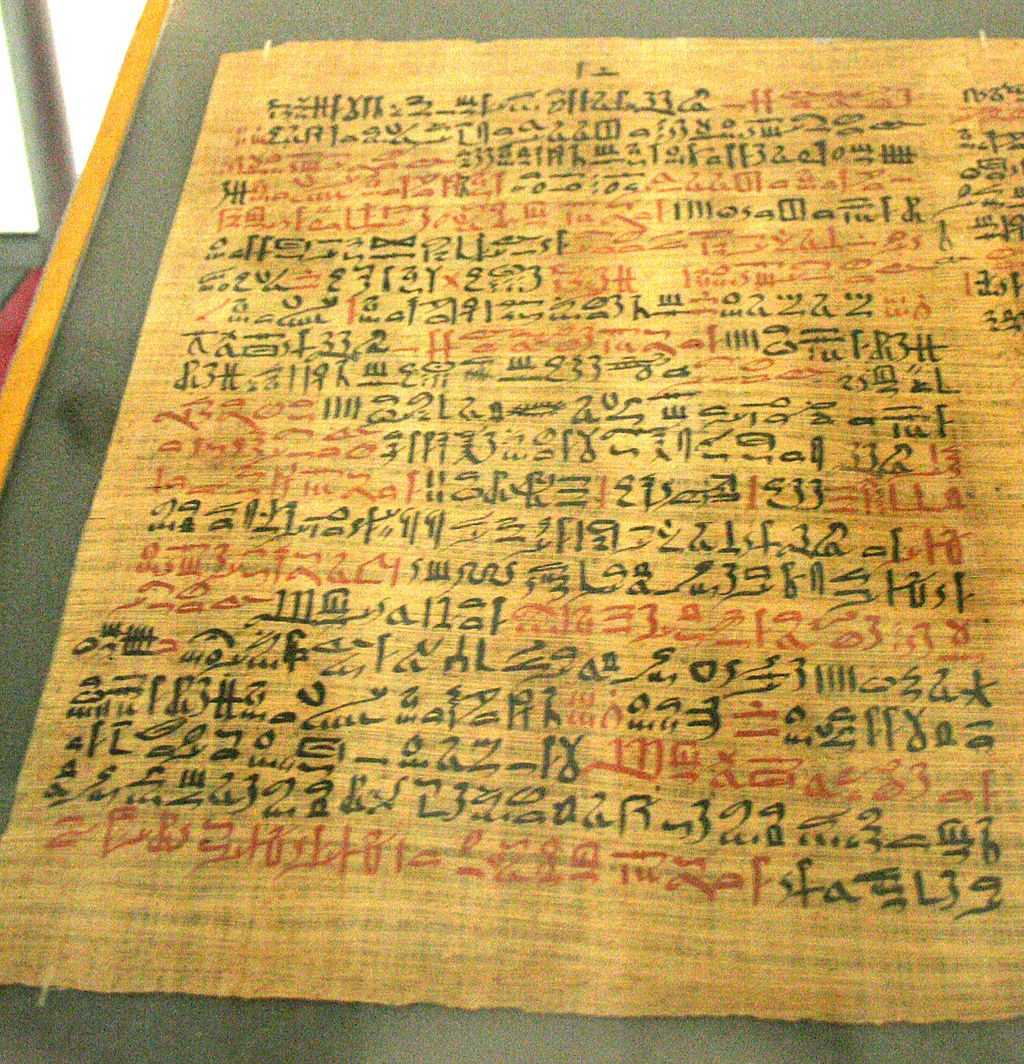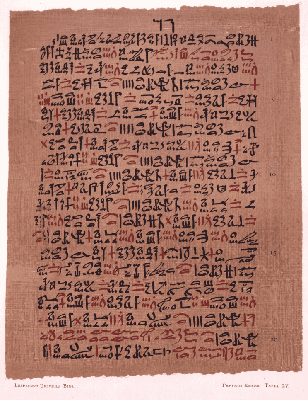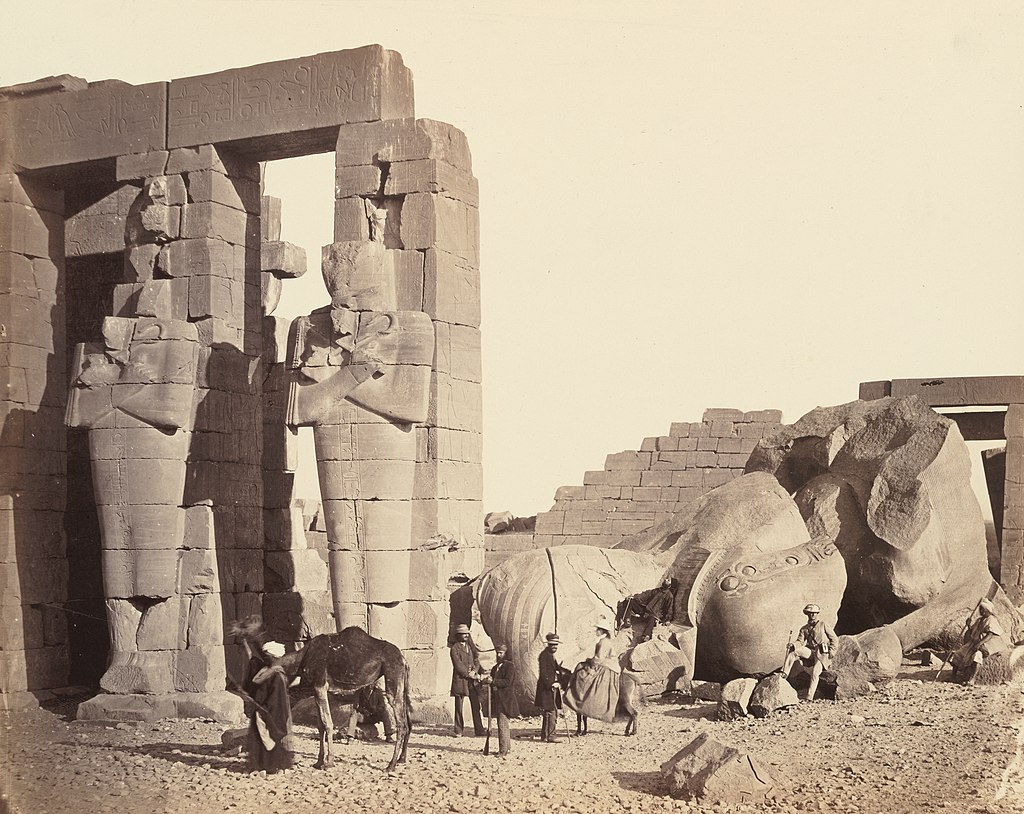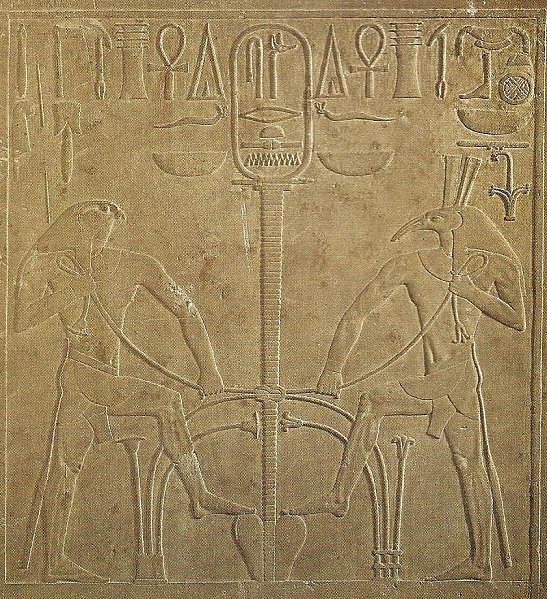The Papyrus Ebers: An Ancient Egyptian Medical Manuscript of Significant Historical and Medical Value
The Papyrus Ebers is one of the oldest and most significant medical documents known to humanity. It is an ancient Egyptian medical manuscript that was written around 1550 BCE, during the New Kingdom period. This papyrus is a testament to the knowledge and expertise of the ancient Egyptian medical community and offers a fascinating insight into the medical practices and beliefs of the time.
Here are some key points about the Papyrus Ebers and its importance:
The Papyrus Ebers, an ancient Egyptian medical manuscript written around 1550 BCE during the New Kingdom period, is a significant historical and medical document that contains over 700 remedies, spells, and incantations for treating a wide range of ailments, diseases, and injuries, and its importance lies not only in its medical content but also in its value as a testament to the knowledge and expertise of the ancient Egyptian medical community and as a reminder of the contributions that ancient civilizations have made to modern medicine, as well as offering valuable insights into the medical practices and beliefs of ancient Egyptians across a wide range of medical specialties including gynecology, ophthalmology, dermatology, and dentistry, and providing a glimpse into the everyday life of ancient Egyptians, their beliefs, and their culture.
Egypt Dynasty | Timeline, List of Egyptian Ancient dynasties and Pharaohs
Content
The Papyrus Ebers is a collection of 110 pages of medical text that contains over 700 remedies, spells, and incantations for treating a wide range of ailments, diseases, and injuries. The document includes descriptions of medical procedures, surgical techniques, and prescriptions for a variety of medicinal substances.

The Ebers Papyrus, page or column 41 (Eb. 204 to 206). PEbers_c41.jpg: Einsamer Schützederivative work: Photohound, CC BY-SA 3.0, via Wikimedia Commons
Details
The Ebers papyrus contains exactly 877 formulas (recipes organized in paragraphs from Eb.1 to Eb. 877). It is not presented as a treatise in the modern sense, but rather as a form (list of prescriptions) where diseases are most often named, or concisely described, rather than diagnosed.
It includes a prologue (Eb.1 to Eb.3) of magic formulas of protection with the aim of protecting the doctor from the demons that cause diseases.
From Eb.4, begins the actual medical sum, which can be divided into thirty-three groups, each group consisting of a list of recipes for the same ailment, or the same kind of ailments. In the presentation that follows, the expression “large group” can mean both the length of the text and its importance for the approach to Egyptian medicine.
Large group 1 (Eb.4 to 187) concerns the diseases of the interior of the body, names the main causes and the corresponding recipes. There are diarrhea, intestinal vermin, pain and burning during defecation.
Large group 2 (Eb. 188 to Eb. 220) is devoted to diseases of the “entrance/opening of the interior-ib”, that is to say, to the departures of all the ducts of the body bringing together the organs (such as the aero-digestive entrances).
Group 3 (Eb. 221 to Eb. 241) concerns diseases associated with the heart-haty; group 4 (Eb.242 to Eb. 260) protective ointments and diseases of the head; group 5 (Eb. 261 to Eb. 283) urine disorders; group 6 (Eb. 284 to Eb. 293) concerns food.
Group 7 (Eb. 294 to Eb. 304) is intended to fight against the setet (pathogenic beings circulating in the ducts of the body); group 8 (Eb. 305 to Eb. 325) against secretion-seryt which causes cough; group 9 (Eb. 326 to Eb. 335) against parasites-gehou responsible for shortness of breath.
Major group 10 (Eb. 336 to Eb. 431) concerns diseases of the eyes.
Group 11 (Eb. 432 to Eb. 436) concerns bites; group 12 (Eb. 437 to Eb. 476) hair care; group 13 (Eb. 477 to Eb. 481) diseases of the liver; group 14 (Eb. 482 to Eb. 514) burns, blows and scars; group 15 (Eb. 515 to Eb. 542) wounds and hemorrhages.
Group 16 (Eb. 543 to Eb. 550) deals with pathological formations and secretions; group 17 (Eb.551 to Eb. 555) abscess-benout; group 18 (Eb.556 to Eb. 591) swellings-chefout; group 19 (Eb. 592 to Eb. 602) eating blood and gnawing substances.
Group 20 (Eb. 603 to Eb. 615) is devoted to affections of the legs; group 21 (Eb. 616 to Eb. 626) fingers and toes.
Major group 22 (Eb. 627 to Eb. 696) concerns met-conducts.
Group 23 (Eb. 697 to Eb. 704) deals with affections of the tongue; group 24 (Eb. 705 to Eb. 738) skin and body surface; group 25 (Eb. 739 to Eb. 749) teeth.
Group 26 (Eb. 750 to Eb. 756) deals with pestilential diseases and demons; group 27 (Eb. 757 to Eb. 760) involvement of the right side by substance-rouyt; group 28 (Eb. 761 to Eb. 763) affected by exudate-rech.
Group 29 (Eb. 764 to Eb. 782) deals with damage to the ears.
Group 30 (Eb. 783 to Eb. 839) is devoted to remedies for women.
Group 31 (Eb. 840 to Eb. 853) concerns home remedies (protection from unwanted animals).
Major group 32 (Eb. 854 to Eb. 856) consists of the “Treatise on the heart” and the treatise on ukhedu (circulating pathogenic substances).
Major group 33 (Eb. 857 to Eb. 877) represents the “Treatise on tumors”.
Rosetta Stone | Without It, We Won’t Know About the Ancient Egypt
Importance
The Papyrus Ebers is significant because it provides valuable information about the medical practices of ancient Egyptians. It is the largest and most comprehensive medical document from ancient Egypt, and it is considered to be one of the most important medical documents from any ancient civilization.

Ebers Papyrus treatment for asthma: a mixture of herbs heated on a brick so that the sufferer could inhale their fumes. Unknown scribe, Public domain, via Wikimedia Commons
Medical knowledge
The Papyrus Ebers demonstrates the medical knowledge and expertise of ancient Egyptians. The text describes many medical procedures that are still in use today, including the use of honey as an antibiotic and the use of willow bark to treat pain.
- Comprehensive medical knowledge: The Papyrus Ebers is a comprehensive medical document that covers a wide range of medical knowledge, including anatomy, pharmacology, surgery, and obstetrics, as well as specific medical conditions and their treatments.
- Detailed descriptions of anatomy: The papyrus provides detailed descriptions of the anatomy of the human body, including the heart, liver, and intestines, demonstrating the advanced medical knowledge of ancient Egyptians.
- Herbal remedies: The Papyrus Ebers contains a wealth of information about herbal remedies and their use in treating medical conditions. It describes the use of various plants, minerals, and animal products, and their preparation for medicinal use.
- Surgical procedures: The papyrus provides detailed instructions for performing surgical procedures, including amputations, cauterization, and dentistry.
- Holistic approach to healthcare: The Papyrus Ebers reflects a holistic approach to healthcare that emphasizes the interconnectedness of the body, mind, and spirit. It includes incantations and spells alongside medicinal treatments, suggesting a belief in the power of the divine to heal.
- Influence on modern medicine: The knowledge contained in the Papyrus Ebers has had a lasting influence on modern medicine. Many of the herbal remedies and medical techniques described in the papyrus are still used today, and the document continues to be studied by medical historians and researchers.
The Papyrus Ebers is a testament to the advanced medical knowledge and expertise of the ancient Egyptians. Its comprehensive coverage of medical knowledge, detailed descriptions of anatomy and surgical procedures, and holistic approach to healthcare continue to influence modern medicine and inspire new discoveries and innovations in the field.

Ebers Papyrus; uterus cancer. Reference to cancer of the uterus. See page for author, CC BY 4.0, via Wikimedia Commons
Medical specialties
The manuscript contains over 700 remedies, spells, and incantations for treating various ailments, diseases, and injuries, with specific instructions on the use of medicinal substances and surgical procedures.
The document covers a wide range of medical specialties, including gynecology, ophthalmology, dermatology, and dentistry. It contains descriptions of the anatomy of the human body and detailed instructions for treating various medical conditions.
The Papyrus Ebers is an ancient Egyptian medical manuscript that covers a wide range of medical specialties, including:
- Gynecology: The Papyrus Ebers provides descriptions of treatments for infertility, menstrual irregularities, and problems related to childbirth.
- Ophthalmology: The Papyrus Ebers describes treatments for eye infections, cataracts, and other eye conditions.
- Dermatology: The Papyrus Ebers provides treatments for skin infections, rashes, and other skin disorders.
- Dentistry: The Papyrus Ebers describes treatments for toothaches, gum disease, and other dental problems.
- The Treatise on Tumors: This treatise is represented by the passage Eb. 857 to Eb. 877. “It is one of the greatest texts of Egyptian medicine, and also one of the most difficult texts to interpret.” It establishes a kind of differential diagnosis between different types of abscesses and tumors by their contents: what is filled with pus and what is filled with something else. Tumors are distinguished by their color, their firmness (hard, soft, etc.), their mobility or fluctuation (literally “rolling under the fingers”), their warmth, and the presence of pain.
- The treatise of the heart: The papyrus contains a “treaty of the heart” represented by the passage Eb. 854 to Eb. 856. It begins with three successive titles: “Doctor’s secret. Know the movements of the heart-haty. Know the heart-haty”. The interpretations differ according to the authors. For some (ancient authors), we would be dealing with a treatise dealing with anatomy (knowing the heart) and physiology (knowing how the heart works, how it works). These authors note that the heart is the center of blood supply, with vessels attached to all the limbs of the body, and that the Egyptian physician palpates the parts of the body and conducts-mets to examine the beats, take the pulse, even count it. Read also: Heart diseases | List of cardiovascular diseases | Include pathologies that affect the heart and all of the blood vessels
Each of these medical specialties is described in detail within the papyrus, with specific instructions for the use of medicinal substances and surgical procedures. The inclusion of such a broad range of medical specialties in a single document demonstrates the advanced medical knowledge and expertise of the ancient Egyptians. Furthermore, the holistic approach to healthcare evident in the Papyrus Ebers highlights the interconnectedness of the human body and the importance of treating each part in relation to the whole. The Papyrus Ebers stands as a testament to the medical practices and beliefs of the ancient Egyptians and their lasting influence on modern medicine.
Historical value
The Papyrus Ebers is not only valuable for its medical content but also for its historical value. The document provides a glimpse into the everyday life of ancient Egyptians, their beliefs, and their culture. It also sheds light on the important role that medicine played in ancient Egyptian society.
Preservation
The Papyrus Ebers was discovered in 1862 by the German Egyptologist Georg Ebers. It was found in a tomb in Luxor, Egypt, and was in remarkably good condition, considering its age. The document was carefully preserved and is now housed at the University of Leipzig in Germany.
Translation and interpretation
The Papyrus Ebers has been translated and interpreted by many scholars over the years. The text is written in hieratic script, which is a form of ancient Egyptian writing that was used for religious and administrative documents. The translation of the text has been a challenging task, but it has provided valuable insights into the medical practices of ancient Egyptians.
The Ebers papyrus is part of a clandestine find in unclear circumstances. It would probably be a chest or a small library from the Ramesseum, which also contained the Edwin Smith papyrus and the Rhind mathematical papyrus.
In 1862, in Luxor, the lot found itself in the possession of Edwin Smith who kept the Smith papyrus for himself, and resold the other two. The Ebers Papyrus was purchased by German Egyptologist Georg Moritz Ebers on behalf of the Leipzig University Library.
It is to Ebers that we owe the name and publication of the papyrus in 1875. This is a facsimile reproduction. Ebers has not attempted a translation, but he gives an introduction with commentary, and an Egyptian-Latin glossary.

The first photograph of the Ramesseum, by Francis Frith, around 1857. National Gallery of Art, CC0, via Wikimedia Commons
Magical wards
The prologue of the Ebers papyrus includes several protection rituals. These are invocations or prayers to be recited before touching the patient, putting on medication, a bandage, or removing this bandage.
These texts are written in the first person, they were interpreted as to be pronounced by the patient or by the doctor on behalf of the patient, but according to Bardinet, they were pronounced by the doctor for his own protection.

An amulet for protection against disease: the eye of Horus or oudjat eye as a pendant (Egyptian Museum in Cairo). Jon Bodsworth, Copyrighted free use, via Wikimedia Commons
The doctor invokes protective gods, mainly Ra, Isis and Horus, against evil forces (demons) or opposites (the god Seth). According to Bardinet, the doctor seeks to identify himself in a magical way with Horus in his mythical struggle against Seth, by addressing himself directly to Isis, protective mother of Horus. Horus and Seth, between the organized world and the disorganized and wild world”.
The patient is himself also assimilated to Horus, but to Horus as a child incapable of defending himself, whereas the doctor is Horus as an adult and acting. The doctor and his patient are therefore close and fight together. According to the Grundriss, the doctor is the magical substitute for the patient, Bardinet disagrees with this interpretation, because “the doctor never takes his patient’s illness upon himself”.
Magical rituals are found in other parts of the papyrus, especially during difficult or dangerous situations. These prayers refer to mythical battles, repeated every day, like those of the crew of the solar boat. The doctor can also be aggressive, hurling curses at demons and evil beings to disrupt their nefarious world.

Horus and Seth, opposite and complementary gods. Rite of Sema taouy or meeting of the 2 lands by Horus & Seth. Soutekh67, CC BY-SA 4.0, via Wikimedia Commons
Dating (calender)
The Ebers papyrus brings together texts of different dates and origins, which can be divided into groups comprising several successive paragraphs. It appears as a compilation of older texts to which are added “new recipes”. This represents a long tradition of empirical knowledge and observations.
It would have been written mainly in the 16th century, around -1550, or during the reign of Amenhotep I. Some Egyptologists give more recent dates and instead cite the reign of Amenhotep III in the 14th or 15th century (date varies according to Egyptologists).
Also, the Ebers Papyrus contains information about the date of Ramesses II’s succession to the throne of Egypt. Ramses II succeeded his father around 1304 or 1279 – 1278. The date is variable depending on how one interprets the Sothic date of this papyrus.
The most recent dating is based on the style of writing, the comparison with other similar manuscripts, and on the presence of a calendar on the back mentioning the ninth year of the reign of Amenhotep I (last quarter of the 16th century BC). . A carbon-14 dating, carried out in 2014, confirms these data (around -1500).
In conclusion
The Papyrus Ebers is a remarkable document that offers valuable insights into the medical practices and beliefs of ancient Egyptians. Its importance lies not only in its medical content but also in its historical value. The document is a testament to the knowledge and expertise of the ancient Egyptian medical community, and it is an important reminder of the contributions that ancient civilizations have made to modern medicine.
Sources: PinterPandai, New World Encyclopedia, Brill, Ancient Origins
Photo credit: See page for author, Public domain, via Wikimedia Commons
Photo description : Ebers Papyrus from National Library of Medicine (www.nlm.nih.gov). Found in Egypt in the 1870s, the Georg Ebers Papyrus contains prescriptions written in hieroglyphics for over seven hundred remedies. This prescription for an asthma remedy is to be prepared as a mixture of herbs heated on a brick so that the sufferer could inhale their fumes.
Egypt Dynasty | Timeline, List of Egyptian Ancient dynasties and Pharaohs



